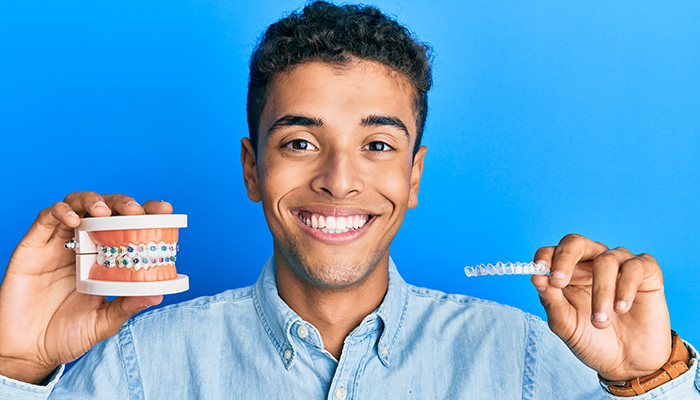Are you going to straighten your teeth? How long does it take Invisalign® to straighten your teeth? Learn more about it right here.
We no longer have to put up with braces, headgear, and other forms of “metal mouth” because we have crooked teeth.
Clear plastic aligners, the most popular of which is Invisalign®, are now popular among both adults and teenagers. Invisalign® promises to straighten your teeth without the use of metal hardware, and its discreet appearance makes it ideal for older teens and adults who do not want to be seen wearing braces.
But how long does it take Invisalign® to straighten teeth, and is it the best option for you? Continue reading to find out.
How Long Does It Take Invisalign® to Straighten Teeth?
If you’re one of the 65 percent of adults in America with misaligned teeth, you’re probably in one of the following categories:
- You never had braces or other tooth alignment as a child.
- You had braces but your teeth shifted over time because you didn’t wear your retainer.
In either case, Invisalign® can help you get a straighter smile faster than you might think. Most patients see results within the first few weeks, and the entire course of treatment takes an average of 12 months. Wearing a retainer after treatment will help keep your new smile from shifting out of place.
Factors That Cause Variation in Wear Time
Everyone’s mouth is as distinct as their fingerprint. As a result, determining an exact treatment duration is impossible. Some patients who only require minor corrections can finish treatment in as little as six months, while others may require up to 18 months.
Here are a few of the main factors that contribute to treatment duration differences.
Teeth Crowding
If your jaw is on the small side (or your teeth are on the large side), you may have misaligned teeth due to crowding. Minor cases of crowding can be corrected in as little as six months, whereas moderate cases can take up to a year. The greater your dental crowding, the greater the distance your teeth must move and the longer the treatment will take.
Gaps in Teeth
Diastema, or gaps between teeth, can occur as a result of tissue overgrowth or teeth that are small in comparison to the jawbone. Minor gaps, like crowding, will take much less time to close than severe gaps.
If you have moderate to severe gaps and crowding, your treatment will likely take closer to 18 months, depending on how quickly your teeth adjust.
In some cases, the jaw is overly large and the teeth are undersized. This may make closing your gaps more difficult. Following Invisalign®, the dentist may recommend additional treatments such as bonding or veneers.
Patient Age
Invisalign® is suitable for both teens and adults, but your age may influence how quickly it works. Teens’ teeth move faster and easier than adults’ teeth because they are still growing.
That being said, some people’s teeth simply move faster than others, regardless of age. Some elderly people may see results much faster than their children (though compliance with a treatment plan might have something to do with that). You are never too old to benefit from clear aligners.
Compliance
Even if your teeth require only minor correction from the start, failing to wear your aligners according to the given instructions can significantly lengthen your treatment time.
Wear your Invisalign® trays for at least 22 hours per day for the best results. You can clean them, eat, and brush your teeth with them out. However, you should wear them at all other times of the day and night, including while sleeping.
If you do not wear your aligners for the recommended amount of time, you may experience treatment regression as your teeth shift back to their original positions.
How Does Invisalign® Compare to Traditional Braces?
Despite the fact that Invisalign® trays are not permanently attached to your teeth, they can work as quickly as or faster than traditional braces. Many adults dislike wearing metal braces for aesthetic reasons, but this isn’t the only disadvantage of traditional braces.
For one thing, eating a crunchy snack makes it far too easy to snap the metal wires, extending your treatment time. This is one of the reasons why braces come with dietary restrictions. A typical brace no-no list includes:
- Crunchy snacks, such as popcorn
- Pretzels and nuts are examples of hard foods.
- Bagels or licorice candies are examples of chewy foods.
- Anything clingy, such as chewing gum or caramel
- Any food that requires biting into, such as whole apples or corn on the cob
Going a long time without your favorite foods is a real drag for those of us who can’t go to the movies without popcorn or a fall festival without eating a caramel apple. However, because Invisalign® trays are removed when you eat, there are no dietary restrictions during your treatment. Furthermore, while acrylic aligners are not indestructible, they are far more durable than thin metal wires and rubber bands.
How Do I Know if Invisalign® Is Right for Me?
The best way to know if clear aligners are the right choice for you is to visit Clear Smiles for a complimentary consultation We have two locations in Houston and Dallas, TX. We will be able to answer any questions you have about the process, including “how long does Invisalign® take to straighten teeth like mine?”


